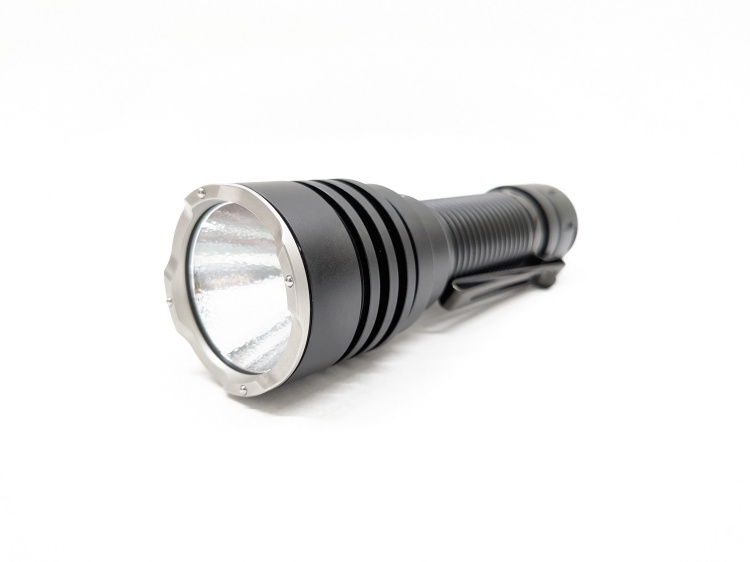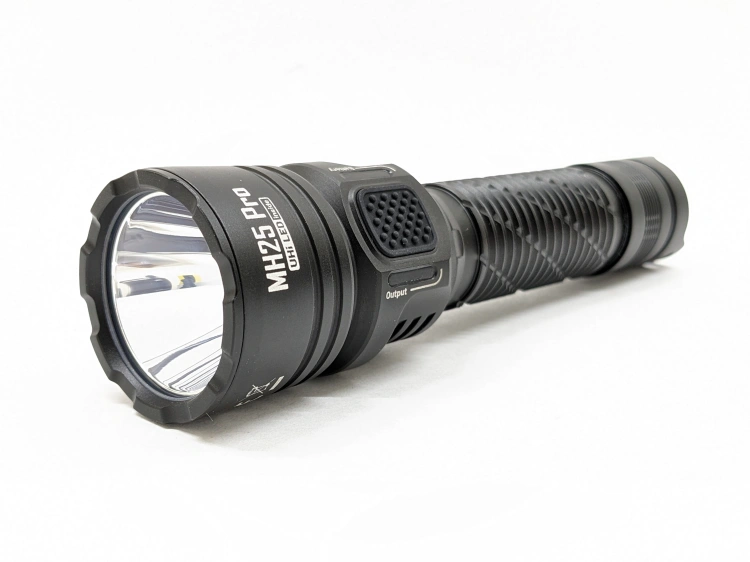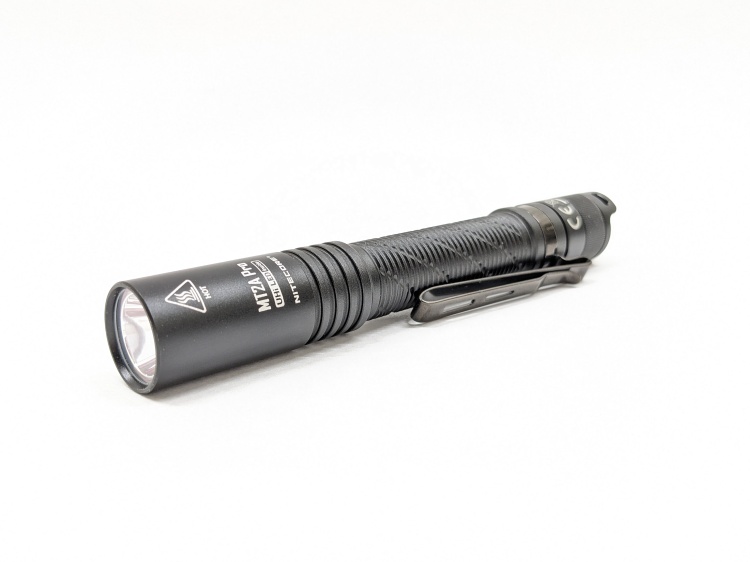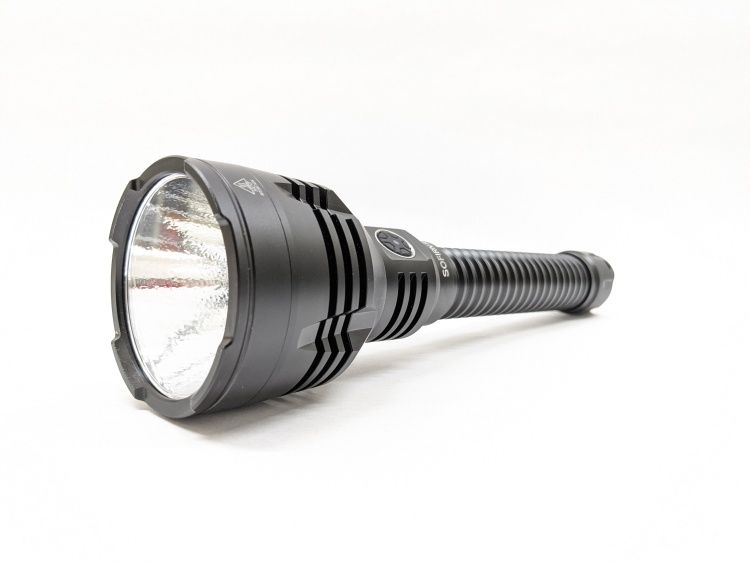Contents
- Pricing & Availability
- What comes in the box?
- Design & Construction
- Size & Measurements
- User Interface
- Emitter & Beam
- Mode Chart
- Runtime
- Driver & Regulation
- Switch
- Carry & Ergonomics
- Batteries & Charging
- Competition
- Conclusion
Pricing & Availability
Jackson Lee of jlhawaii808.com sent me this light in exchange for an honest review. Here’s the product page on jlhawaii808.com and here’s the manufacturer’s official product page. Ordering from the manufacturer is a little cheaper but the shipping is very slow. Jackson is the official US reseller for Emisar & Noctigon flashlights and he offers super fast shipping and great customer service. He does all the US warranty repairs on Emisar/Noctigon flashlights and even offers out of warranty repairs too!
What comes in the box?
The box is Emisar/Noctigon’s typical cardboard box with a sticker on the top and a one-size-fits-all foam insert. The following items are included in the box:
- The light itself
- Spare o-rings
- Wrist lanyard
- Any additional accessories you may have purchased (pocket clip, magnetic tailcap, and a user manual are included by default from jlhawaii808.com
Design & Construction
D4K looks just like Emisar D4V2 but with a slightly larger body tube and tailcap. It’s a nice design but it’s not as sleek and elegant as the Noctigon KR series.
Build quality is pretty good, as is typical from Emisar/Noctigon. The green anodizing is evenly applied and looks good, but it’s started to wear on the tailcap after 2-3 weeks of carry. It’s not as durable as black anodizing I usually prefer. The threads are smooth, anodized, trapezoid cut, and lubricated from the factory. The body tube is not reversible.
Size & Measurements
Olight Baton 3 | Lumintop FW3A | Emisar D4K | Emisar DW4 | Cyansky K3

| Measurement | Measured (mm) |
|---|---|
| Bezel Diameter | 28.0 |
| Maximum Head Diameter | 32.3 |
| Length | 103.4 |
| Switch Diameter | 11 |
| Switch Proudness | -0.4 |
| Lens Diameter | 25.6 |
| Lens Thickness | 1.5 |
| MCPCB Size | ~24 |
| Body Tube Diameter (internal) | 22.2 |
| Body Tube Diameter (maximum) | 27.0 |
| Body Tube Diameter (mode) | 25.0 |
| Body Tube Length | 76.0 |
| Ride Height (sticking out of pocket) | 2.4 |
| Pocket Clip Space (for pants material) | 2.7 |
| Pocket Clip Space (at mouth) | 5.2 |
| Pocket Clip Width | 7.0 |
| Pocket Clip Thickness | 1.0 |
| Pocket Clip Slot Width | 3.1 |
| Pocket Clip Slot Diameter | 24.0 |
| Tailcap Diameter | 27.0 |
| Tailcap Length | 17.6 |
| Driver Diameter | ~24 |
Weight without battery: 75g
Weight with Molicel P42A battery: 140g
User Interface
D4K comes with a firmware called Anduril 2. It’s a highly-configurable and feature-rich UI that’s not for the faint of heart, but it’s a joy to use if you know it well. It’s too much to include a full UI breakdown here, so I’ll just direct you to the official Anduril 2 Manual which has a UI table at the bottom. With that said, here are a few of my favorite features. Most of these are highly configurable or optional, so if you don’t like one, you can probably disable or change it!
- Momentary Turbo
- Adjustable Stepped Modes
- Manual Mode Memory option
- Shortcuts to & from Moonlight, Turbo, and High
- Battery voltage readout
- The best LVP behavior in the industry
- Support for RGB auxiliary LED’s
Emitter & Beam

D4K is available with a wide variety of emitters from intl-outdoor.com and even more from jlhawaii808, who will swap in whatever emitters you want upon request. He even carries all the Nichia 519A color temperatures that intl-outdoor.com doesn’t stock!
I chose Nichia 519A LED’s in 4500K for my review sample. They still have the domes but you can get them de-domed for warmer color, a little bit narrower beam, and rosier tint. I also requested that Jackson install a Carclo 10621 Narrow Spot optic, which is not the default. He was happy to oblige.

Domed 519A’s work really well with the 10621 optic. They produce a wide and fairly well-defined hotspot that I find very pleasant to use. There are a few minor artifacts here and there that you may notice when white-wall-hunting but overall it’s a delightful beam shape and I highly recommend this combination. I just love the crisp circle hotspot.
In the beamshots below, the basketball goal to the right of the hotspot is 39M away and the pole in the power pole in the center is 185M away.








Aux LED’s: There are eight RGB auxiliary emitters behind the TIR optic in the front of the light. There are also lights behind the switch which can be RGB or a fixed color. They’re all controlled by the aux LED function in Anduril 2. They can be set to one of 10 different colors/color paterns, one of three different color patterns, and one of four brightness levels/paterns. They’re very cool looking and add some nice flare to the light. You can also use them to locate the light in the dark or tell how charged the battery is at a glance, but they aren’t good for illuminating other objects.
I find the aux LED’s are too bright on high mode. It’s not a huge deal and it’s been happening since Hank first introduced aux LED’s, but I’d still like it to be fixed. If I have the light sitting on my nightstand at night I can see the light coming from the aux LED’s on the ceiling. They also drain the battery faster than I’d like on high mode (less than 1 month) according to my parasitic drain tests. I think just adding some resistors into the aux circuit would do the trick.
Mode Chart
Disclaimer: All of my measurements are taken at turn-on. Lumen measurements were taken on a Texas Ace 3.5″ Lumen Tube. A candela measurement was taken at 10 meters with an Opple Light Master III on the highest brightness, and other candela figures were calculated relative to that. CRI, CCT, & DUV data was taken for each mode from a few feet away at the center of the hotspot with the Opple Light Master and Waveform DUV Calculator. Runtime tests were performed with the Ceilingbounce app on my smartphone. All of these tests were performed with a fully charged Molicel P42A battery unless otherwise specified. I cannot measure moonlight directly, so moonlight readings are calculated based on the brightness relative to the next-lowest mode. None of this is professional equipment, so take all of these measurements with a grain of salt.
There are so many different options when ordering a D4K that it really doesn’t have official specifications. Below are my measurements for this configuration.
| Level | Lumens | Candela | Throw (Meters) | CRI (Ra) | Color Temp. (K) | DUV (Tint) |
| Turbo | 3900 | 12000 | 219 | 96 | 4490 | -0.0052 |
| High | 1600 | 4923 | 140 | 97 | 4380 | -0.0020 |
| Medium | 370 | 1138 | 67 | 98 | 4330 | -0.0010 |
| Low | 35 | 108 | 21 | 98 | 4260 | -0.0011 |
| Moonlight | 0.17 | N/A | N/A | N/A | N/A | N/A |
Why those modes? Anduril 2 has 150 levels, so doing measurements and tests for each mode is virtually impossible. I’ve got this light set up how I like it with 5 levels. Bottom of ramp is level 1 and top of ramp is level 120 (the highest regulated level). I’ve set up the stepped ramp with 4 steps so, with turbo added, I get the 5 modes I like.
Moonlight: I find that ~0.5lm is just right for moonlight. 0.1lm and below is too dim to be useful and above 1.0lm is too bright for some situations. I chose to measure the lowest moonlight level on this light but you can adjust the moonlight brightness to suit your needs. It’s also worth noting that the boost driver and dual-channel versions of D4K have a higher moonlight level than this linear+FET version.
Mode Spacing / Ramp Speed: is good. There are no weirdly small or large jumps between stepped modes and smooth ramping looks visually linear.
Runtime

Note: Before doing any testing I calibrated the thermal sensor. All tests were run with the thermal ceiling at the default 45C.
Performance: is very impressive for ~15 seconds, then output drops like a rock. That happens whether cooled or uncooled, which is odd. After that output settles down around 250 lumens when uncooled and around 900 lumens when cooled and with the thermal ceiling raised. That’s not very impressive but should not be detrimental to the light’s usefulness.
Thermal regulation: Anduril 2 usually has the best thermal regulation available, but this light behaves a little differently. It appears to step down hard regardless of whether it’s being cooled or not, and active thermal regulation only appears to kick in after ~30 seconds. Normally I expect it to kick in at 10 seconds, and that’s what I’ve observed from other Anduril 2 lights.
LVP (Low Voltage Protection): Anduril 2 will lower the brightness in noticeable steps when the battery gets low. When the battery is empty it will shut the light off completely. You can still turn it back on briefly for emergencies though. It’s very good at extending battery life when the cell is low, so I didn’t wait for it to fully shut off in any of my tests to save time.
Driver & Regulation
D4K is available with three drivers: Linear+FET (what I have, provides the brightest Turbo and the lowest Moonlight), Boost (not as bright, way more efficient, less heat, better regulated), and dual-channel (supports two sets of LED’s and lets you switch between them).

Regulation is average. Turbo is heavily affected by cell voltage but the other modes are largely unaffected. Regulation on the dual-channel driver should look similar. The boost driver should have near-perfect regulation.
Note: All regulation measurements are taken at turn-on so they do not reflect any thermal or low voltage stepdowns that may occur. A value of 0 indicates low voltage shutoff immediately upon activation.
PWM: No PWM is visible to my eyes or camera, but it’s audible to me between level 120 and level 150. Levels 1-120 & 150 should not have any PWM.
| Aux LED Status | Parasitic Drain (μA) | Time to Drain 4000mah Battery |
| High (“White”) | 6900 (6.9mA) | 24 days |
| Low (“White”) | 82 | 5.6 years |
| Off | 15 | 30.4 years |
Switch
The switch is the same one that Emisar lights have been using for a long time. It’s a backlit electronic side switch with a rubber boot and a press-fit retaining ring (flat or raised). Flat provides better access to the switch but raised does a better job protecting against accidental activation. I highly recommend you go with the raised switch ring.
The fancy metal D4K’s now come with a threaded retaining ring that’s between the flat and raised press-fit rings. That’s going to make its way to the aluminum version very soon as well. The switch is tactile and clicky enough. It’s also plenty easy to use even with the raised ring.

The backlight is very bright, especially if you choose a single color instead of RGB. The RGB backlight doesn’t mix very well, so if you have a combination color selected (like “white” shown above), you’ll just see the individual red, green, and blue LED’s under the switch instead of an evenly mixed color.
Carry & Ergonomics
D4K is small for its battery size and that shows in the ergonomics. It’s a little bit short in my large hands but it’s totally usable, and it’s noticeably better than D4V2. The milling provides plenty of grip and there aren’t any sharp spots. A forward grip works best but a pencil grip is also usable.
D4K carries very well. As I said, it’s small for its battery size. This feels smaller in my pocket than some of my 18650 lights and it’s a joy to carry. It doesn’t feel meaningfully larger or heavier than a D4V2 either.
The pocket clip works very well. This is a much better clip than the one that used to be available for D4V2. It slides in & out of the pocket nicely. The tension is just right out of the box. It carries nearly flush with the tailcap. The only thing that would make it better is if it were captured by the tailcap so it couldn’t rotate. I’m a pocket clip snob and I have no desire to change this clip. Well done.
Tailstand: works well and is very stable
Magnet: is super strong. No problem sticking to any surface I tried.
Batteries & Charging

D4K uses one unprotected flat top 21700 cell. Something with a ~20A+ discharge rating is best unless you get the boost driver. Then 10A+ will be just fine. I did all my testing with a Molicel P42A but the light did dent the positive terminal on the cell a bit. That’s not a problem because the cell still works fine, but there are other lights that don’t do that, so this one shouldn’t either.
You can also fit a protected button top 18650 cell if you want to. You’ll just need to use a shim around the battery to prevent rattling. Keep in mind almost every protected cell’s protection circuit will be tripped if you use Turbo mode (or even High mode) but it will fit. It may even be possible to use a cell with a USB charging port on it but I’m not certain.
No charging solution is included.
Competition
Here are some lights in the same class and how they compare.
Wurkkos TS25: closest thing to D4K that comes with a battery & USB-C charging. Same battery type, UI, switch location, and RGB aux. Slightly larger, black body only, weak magnet, bidirectional clip, worse driver, few emitter options, and a cheaper price tag.
Noctigon KR4: very similar but with a metal tail switch and an 18650 battery instead of 21700. No magnetic tailcap but it does have the best pocket clip I’ve ever used.
Skilhunt EC300: similar size & shape, different UI, USB-C charging, much brighter red/green/blue secondary LED’s that are not on all the time, not as bright, fewer emitter options, no magnet
This section is not comprehensive. If I didn’t include a particular light here, it doesn’t mean it’s bad or doesn’t deserve to be here. I simply cannot list every possible competitor.
Conclusion
D4K is a great addition to the Emisar/Noctigon lineup. It takes everything great about D4V2 and pairs it with a higher output, higher capacity 21700 cell. The beam on my sample is just delightful and I find Anduril 2 a treat to use day-to-day. If you’re looking to pack a lot of power, bells, and whistles into an EDC size package, look no further than D4K.
Thanks to Jackson Lee of jlhawaii808.com for sending me this light for review! If you’re in the US, get your D4K from him for super fast shipping!
































